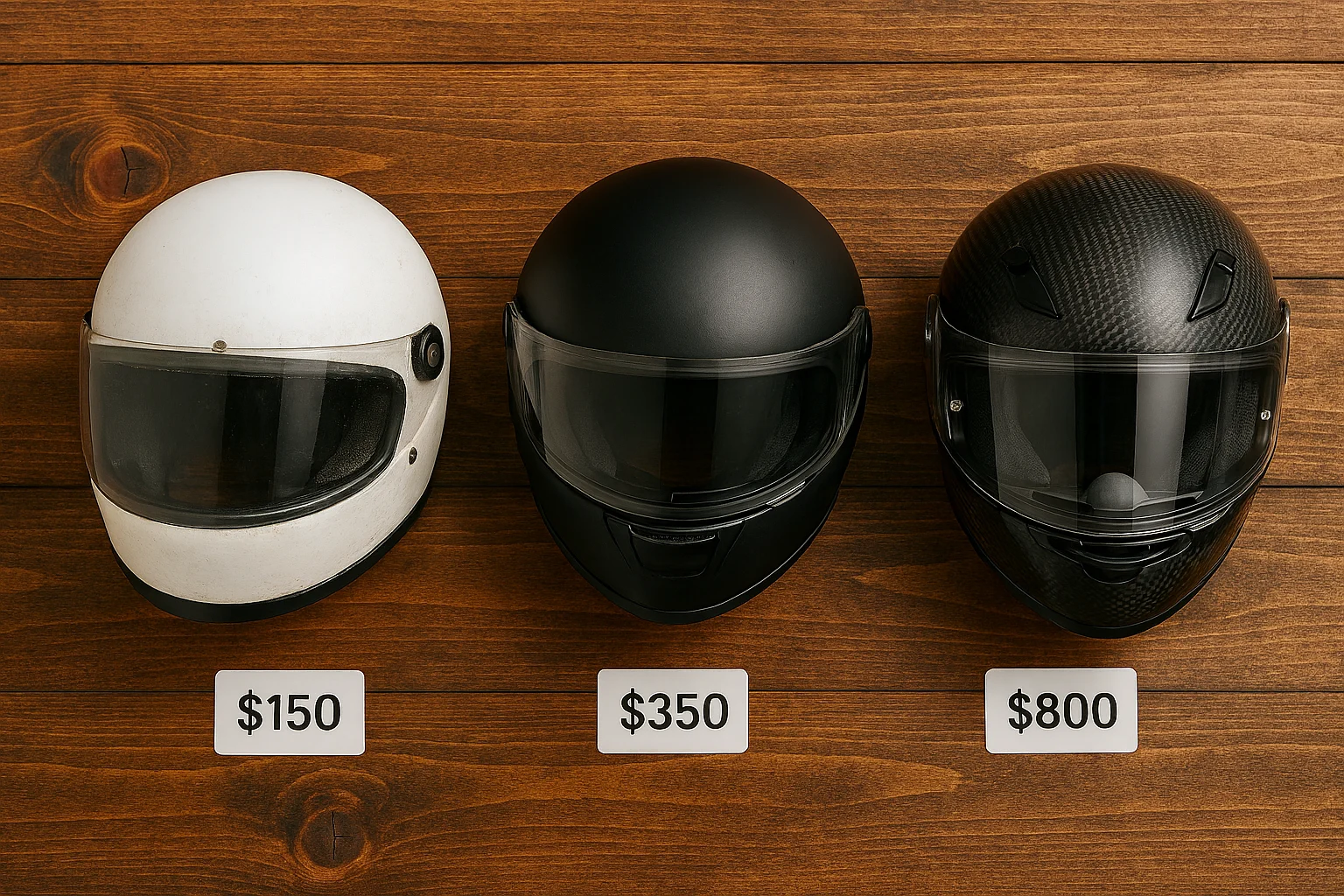When I got my motorcycle license a couple of weeks ago, I was over the moon. I had finally stepped into the world I’d dreamed about for years. So, how much is a motorcycle helmet? I picked up my Yamaha XT 250, which felt like the perfect first bike for me. I was ready to ride, but one thing kept bothering me, my helmet.
The helmet I was using was a hand-me-down. It had been lying around from a friend who no longer rode. At first, I thought it would be fine. After all, it looked like a proper helmet, and I could save a few bucks. Looking for both convenience and security? Learn whether Modular helmets are safe and how they stack up in protection.
But on my first few rides, I noticed two things: it felt a little loose and it was definitely not comfortable on longer trips. I kept adjusting it, and that’s when I started to worry about whether it would protect me properly if I ever had an accident.
That got me thinking. How much should I actually be spending on a motorcycle helmet? And more importantly, what should I be looking for to make sure I am safe and comfortable on the road?
This is the journey I went on to figure that out, and I want to share everything I learned so you can make a smart choice too, especially if you are a biker like me who values both safety and enjoyment.
Why a Good Helmet Matters More Than You Think
When you ride a motorcycle, your helmet is the single most important piece of safety equipment you will ever own. Unlike a car, there is no metal frame, airbags, or crumple zones around you. If something goes wrong, your helmet becomes your best defense against serious head injury.
A loose helmet is dangerous because it can move around during a crash, leaving parts of your head exposed. It can also come off entirely if the straps are not secure or if the fit is too big. That is why a perfect fit is not just about comfort, it is about survival.
For bikers, especially those riding in mixed traffic or at higher speeds, the risk is always present. Even a short ride to the store can turn dangerous if a car driver does not see you or if the road is slippery. That means your helmet should not be something you compromise on. Curious about the safety trade-offs? Find out whether modular helmets are as safe as full-face before you decide.
How I Started My Helmet Search
The first thing I did was set my priorities. Since money was not a problem for me, I wanted a helmet that was top-quality, fit me perfectly, and had strong safety ratings. I also wanted one that looked good because let’s be honest, style matters too.

Here’s how I broke it down:
- Safety Certification: I learned that helmets come with safety ratings like DOT (US standard), ECE (European standard), and Snell (independent testing standard). For me, at least DOT and ECE were non-negotiable. Snell was a bonus.
- Fit and Comfort: I went to a local motorcycle gear shop and tried on different brands. The shop staff explained that the helmet should feel snug but not painfully tight. When I shook my head, it should move with my head, not slide around.
- Type of Helmet: I ride both on-road and occasionally on trails, so I considered full-face helmets and dual-sport helmets. Full-face helmets offer the most protection overall, while dual-sport gives you more airflow and a wider field of vision.
- Noise and Ventilation: I had not thought about wind noise before, but once you ride at highway speeds for a while, it becomes clear how important a quiet helmet is. Good ventilation also keeps you comfortable during long rides.
How Much Is A Motorcycle Helmet: Price Ranges and What You Get
While researching, I found that motorcycle helmets can range from around $100 to over $1000. Here is what I learned about each range:
Budget Helmets ($100–$250)
These are often entry-level helmets. They can still be safe if they have DOT or ECE certification, but the materials, comfort, and noise control may not be as good. They are good for beginners on a tight budget, but I wanted something higher-end.
Mid-Range Helmets ($250–$500)
This is where you start to see a big jump in comfort, build quality, and features. Many helmets in this range are made with lightweight composite materials, have better aerodynamics, and are more comfortable for long rides.
Premium Helmets ($500–$1000+)
These helmets use advanced materials like carbon fiber, have excellent ventilation, superior noise reduction, and high-end padding that molds to your head over time. They also tend to be lighter, which reduces neck strain on long rides. If you ride often, this price range is worth it. Want to understand the hype? Get a clear explanation of what a modular motorcycle helmet is and how it works.
Why I Chose a Premium Helmet
As a biker, I see my helmet as an investment in my safety and riding experience. I chose a premium helmet for three main reasons:
- Lightweight comfort for long rides so my neck does not ache.
- Top-tier safety ratings to give me peace of mind.
- Better fit so I am not distracted adjusting it mid-ride.
I went with a Shoei RF-1400 after trying several options. It fit like a glove, had excellent visibility, and was surprisingly quiet on the highway.
How This Helps Bikers Specifically
For bikers, especially those who ride daily or travel long distances, the benefits of a proper helmet are huge:
- Reduced fatigue because a well-fitted helmet is lighter and more balanced.
- Better concentration since you are not constantly adjusting it or dealing with wind noise.
- Increased confidence knowing you have maximum protection.
- Improved riding experience with better airflow and visibility.
If you enjoy riding twisty backroads, commuting to work, or even weekend touring, you will appreciate how much a high-quality helmet changes the feel of your rides.
Mistakes I Almost Made (and You Should Avoid)
- Buying Online Without Trying First: Helmets fit differently depending on the brand. A medium size in one brand might feel like a large in another. Always try before you buy.
- Ignoring Safety Ratings: Just because a helmet looks cool does not mean it is safe. Always check for certification labels inside the helmet.
- Not Replacing Old or Dropped Helmets: Helmets have a lifespan of around 5 years. Also, if you drop your helmet hard, the inner protective foam can be damaged even if it looks fine.
Tips for Finding the Perfect Helmet
Here’s what worked for me and can help you too:
- Visit a motorcycle gear store and have them measure your head.
- Try different models and keep them on for at least 10 minutes to check for pressure points.
- Move your head side to side and up and down to test stability.
- Choose a visor that offers UV protection and does not fog easily.
- Look for removable liners so you can keep the helmet fresh.
Final Thoughts
In the end, the question of “how much is a motorcycle helmet” really comes down to how much value you place on your safety and comfort. For me, spending more made sense because I ride often and want the best protection available. My advice is to buy the best helmet you can comfortably afford and make sure it fits you perfectly.
Riding is one of the greatest joys I have found in life, but it also comes with risks. A helmet is the one thing that stands between you and serious injury if the unexpected happens. Do not cut corners here.
Whether you are a new rider like me or a seasoned biker with thousands of miles under your belt, your head deserves the best protection you can give it. Ready to buy your next helmet? Discover where to get a motorcycle helmet from trusted retailers and dealerships near you.





